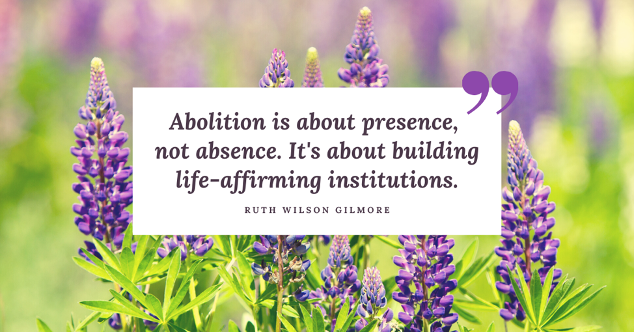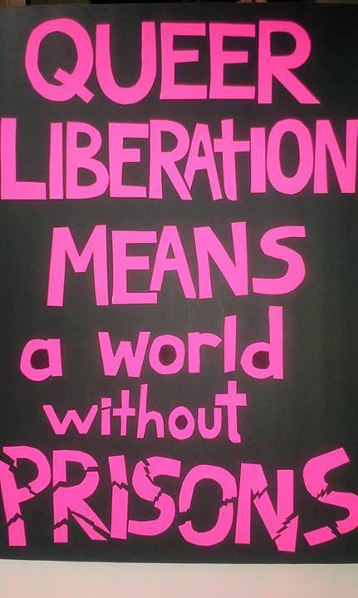Hey everyone! Esrea Perez-Bill (she/her and they/them) and Dylan Felt (she/her and they/them) here from the EDIT Program to talk LGBTQ+ resistance, abolition of the carceral and police state, and evaluation. As calls to #DefundThePolice have gained national attention, lots of folks are being newly introduced to abolition, and many may be feeling confused, afraid, or even frustrated by these calls.

Lesson to Learn: Abolition is nothing to be afraid of!
It’s important to remember that abolition isn’t just about the absence of police and prisons, it’s about the systems of care, support, and health that we build in their place. There is a wealth of research available on how police violence harms health, or how the prison system disproportionately impacts poor, Black, Indigenous, Latinx, and LGBTQ+ communities, but identifying these dynamics is only a first step. A philosophy of abolition pushes us not only to reject and dismantle harmful systems, but to build in their place a loving, healthy, supportive world.
LGBTQ+ communities of color have long been at the forefront of re-imagining the world in a more caring image. Just look to Black LGBTQ+ ballroom culture, which created a structure of chosen family for LGBTQ+ children who had been kicked out of their homes at the height of the AIDS crisis, fostering health and community care by moving beyond a traditional, western family structure. In ballroom, community leadership revolutionized the potential for growth and wellbeing among some of the most marginalized members of society by shrugging off a harmful system and instituting a better one in its place. In fact, abolition and the leadership of LGBTQ+ communities of color have always gone hand in hand. As Dr. Angela Davis, a leading voice in abolitionist theory and a Black lesbian herself, says:
“… the trans community … has taught us how to challenge that which is totally accepted as normal. If it is possible to challenge the gender binary, then we can certainly effectively resist prisons and police.”
Hot Tip: As evaluators, we ask tough questions, we think critically about complex problems, and we use available evidence to find creative solutions that benefit those we serve. We argue that the evidence is clear: police and prisons create more harm than good, and it’s time to consider: At what point do we stop interpreting – and start abolishing? What can our role as evaluators be in manifesting a better future – one that holds health, justice, and equality as core values?
Rad[ical] Resources:
If you want to learn more about abolition, Black, Queer, and Feminist scholars and activists have been writing about it for years! Here are some of our favorite resources if you’re new to what abolition means:
- Are Prisons Obsolete? by Angela Davis
- Captive Genders: Trans Embodiment and the Prison Industrial Complexby various authors
- Black & Pink – a national LGBTQ+ abolitionist organization
- Critical Resistance – a group advocating for and educating on abolition
We invite you all to join us in this conversation.

The American Evaluation Association is celebrating LGBT TIG Week with our colleagues in the Lesbian, Gay, Bisexual & Transgender Issues Topical Interest Group. The contributions all this week to aea365 come from our LGBT TIG members. Do you have questions, concerns, kudos, or content to extend this aea365 contribution? Please add them in the comments section for this post on the aea365 webpage so that we may enrich our community of practice. Would you like to submit an aea365 Tip? Please send a note of interest to aea365@eval.org. aea365 is sponsored by the American Evaluation Association and provides a Tip-a-Day by and for evaluators.

My apologies, the above response was meant to be addressed to Esrea Perez-Bill & Dylan Felt.
Jacqueline
Hi Sheila,
As a teacher of Anthropology and a Master’s student at Queen’s University, taking a course on Program Evaluation, your post really resonated with me. Particularly your statement, “At what point do we stop interpreting – and start abolishing?”. From an evaluation standpoint, this statement is akin to the point made by Kirkfield (2000) in her article, Reconceptualizing evaluation use: An integrated theory of influence, that evaluation needs to be “the stimulus that causes instrumental or conceptual change to take place” (pg 7). In my opinion, there has never been a time more perfect for this type of subversive action.
What I have taken from your post as one of the most crucial concepts is the term “re-imagining” and the awesome potential this word has. You have made reference to ballroom culture, to which I was not formally familiar with, and it really made me think about how much this needs to garner more attention. As someone who has studied and teaches Anthropology, kinship structures and hierarchy are vital concepts to analyze from a cross-cultural standpoint and are crucial to understanding human behavior and group dynamics. I am a firm believer that the past has gifted us with important lessons and warnings from which to learn from and if we study and evaluate these lessons, we can better the future for ourselves and others. We need to take off this Western lens through which many of us see the world and start to examine alternative modes of social and political organization. Those that don’t rely on oppression, conformity and violence, but as you state restructure our reality into “a loving, healthy, supportive world.”
I am often wary of the social media hashtags that state often misunderstood ideas like #defundthepolice, as they lack the context to provide naysayers with clarity. I’ve heard responses within my social circle such as “well then what do we do with all the criminals?” or “who do you call when you’re in trouble”, but as you state, “It’s important to remember that abolition isn’t just about the absence of police and prisons, it’s about the systems of care, support, and health that we build in their place.” Many tend to forget that abolitionist movements of the past were successful in abolishing slavery, witch hunts, Residential schools, child labor and depending on the area of the world the list goes on.
There are numerous examples around the world of what this re-structured judicial system could look like. Even here in Canada, as we see and over-representation of Indigenous people targeted by police and the judicial system there are changes being made. According to a report by the Aboriginal Justice Inquiry in Manitoba, commissioned in 1999, it was observed that there was an overrepresentation of Indigenous people in the judicial system and their recommendations included a re-imagining of the system, which included, sentencing panels, elder and community involvement in rehabilitation, restitution structure, focus on spiritual fulfillment, counseling and community integration, not separation. My point here is that the need for this re-imaging or #de-funding is not a new concept. In addition to this, there are nine Healing Houses across Canada that are centered around healing, spirituality, Indigenous programming and community interaction and social rehabilitation and these programs seem to be working. In fact, according to Correctional Service Canada (CSC), as of 2019 “all CSC institutions, approximately 85 percent of CSC’s Indigenous offenders are working with Elders and committed or interested in following a traditional path. In comparison, about two percent of non-Indigenous offenders are following a traditional path. (Government of Canada, 2019).
I firmly agree with you that program evaluation has never been more important, but it has to be what we do with the information that will move us forward into a future that you depicted as “one that holds health, justice, and equality as core values”
Thank you for sharing your thoughts!
Sincerely,
Jacqueline Barrow
References
Aboriginal Justice Implementation Commission. (2001, June). Report of the Aboriginal Justice Inquiry of Manitoba. http://www.ajic.mb.ca/volume.html
Government of Canada. (2019, September 5). Indigenous healing lodges. Correctional Service Canada. https://www.csc-scc.gc.ca/aboriginal/002003-2000-en.shtml
Kirkhart, K. E. (2000). Reconceptualizing evaluation use: An integrated theory of influence. New Directions for Evaluation, 2000(88), 5–23. https://doi.org/10.1002/ev.1188
Jacqueline, thank you so much for your comment! We’re so happy this piece resonated with you – it meant a lot to us to have the opportunity to write and share this perspective with other evaluators. This is exactly the sort of discussion that we were hoping to be able to have through this piece, and we’re so thankful for your thorough and thoughtful reply here.
We could not agree with you more – we all, individually and as a field, would benefit so much from taking off our Western lens, and from looking to the leadership of Black, Indigenous, LGBTQ+, and other oppressed peoples who have been paving the way towards abolition and a more loving world for generations. We strongly believe that there is a role for evaluation and evaluators in helping to create that world, but we have to be willing to think outside of the boxes and systems we’ve been trained to think in, and as you say, use the information and skills we have to help further these necessary movements. If we aren’t working towards a world that is loving, that is healthy, that is kind, then what are we working for?
The limitations of social media that you raise are also such an interesting topic. Hashtags like #defundthepolice are so effective in helping an idea to reach a really broad and diverse audience, but they also often are vulnerable to mis-appropriation, misinterpretation, and as you say, don’t always provide all the context and information that more in-depth messaging or organizing are able to provide. In the case of this hashtag, we’ve certainly noticed how vulnerable it is to being watered-down by well-meaning folks who aren’t familiar with the history and philosophy of abolitionist movements. That’s why discussions like this are so important too – we can’t just rely on a tweet to inspire a movement, but we need to be speaking to and engaging with our friends, our colleagues, or families, our neighbors, and our communities.
As you mentioned, the work of re-imagining our world holds an incredible potential. As evaluators, we must forgo the individualized route that has been paved by these western, colonial lenses that we’ve discussed – and come together as a collaborative. It is crucial that when we re-imagine our world, we do so together, which means nurturing the communities that we are a part of.
With this being said, if you want to talk about this more and/or strategize with us about how evaluation can be a part of abolitionist movements, please shoot us an e-mail! We’d love to continue this conversation! We’re at esrea.bill@northwestern.edu and dylan.felt@northwestern.edu
Thank you again for sharing your thoughts,
Esrea & Dylan